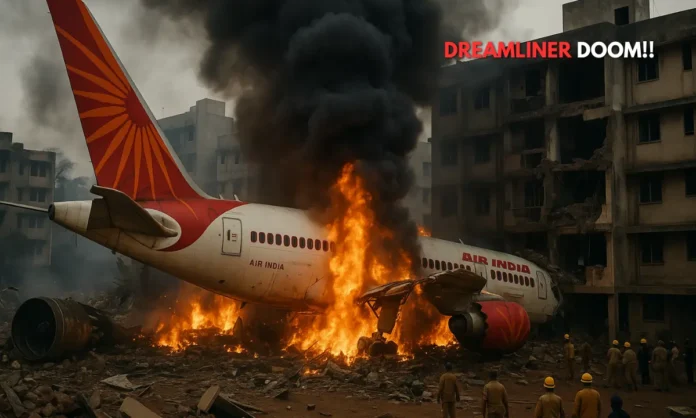Summary
- DGCA’s post-crash audit uncovered critical maintenance lapses and outdated safety protocols at major airports.
- Findings included ignored aircraft defects, worn tires, outdated simulator software, and unrecorded system errors.
- The audit reveals a widening safety gap in India’s fast-growing aviation sector, now under urgent regulatory pressure.
Beneath the Runway: How a Tragedy Triggered India’s Most Damning Aviation Safety Review
On June 12, 2025, flight AI171—a Boeing 787 Dreamliner operated by Air India—crashed into a medical college hostel in Ahmedabad, killing 241 people onboard and dozens on the ground. It was the deadliest aviation disaster in India in over two decades. What followed was not just a national mourning—it was a regulatory reckoning.
The Directorate General of Civil Aviation (DGCA), India’s civil aviation watchdog, launched an urgent, sweeping audit of the country’s airline operators and key airports. Its findings, now public, have sparked outrage and alarm. The India aviation safety audit Air India crash 2025 revealed not a single-point failure, but a systemic collapse across aircraft maintenance, ground handling, air traffic coordination, and regulatory enforcement.
With India poised to become the world’s third-largest aviation market by 2030, the audit raises a disturbing question: is the country’s air safety infrastructure equipped to handle the volume, speed, and complexity of its aviation boom?
SHOCKING! Major Airlines FAIL Safety Checks!
— NewsToday (@HealthMav) June 24, 2025
Watch: https://t.co/CK04QX2piD#airports #maintenance #Mumbai #Delhi_Airport #India #Air_India #Delhi #DGCA pic.twitter.com/DHQdLxCSEK
The Audit Trail: What the DGCA Found
- Aircraft maintenance engineers ignored standard safety precautions and failed to report critical defects.
- Automated system-generated snag alerts were not recorded in technical logbooks.
- One domestic flight was grounded due to worn-out tires discovered during inspection.
- A simulator used for pilot training was not configured correctly and ran outdated software.
- Obstruction-limitation data at one airport hadn’t been updated in three years, despite nearby construction.
The DGCA’s post-crash audit covered India’s two busiest aviation hubs—New Delhi and Mumbai—as well as Air India and other domestic operators. What they found was an industry flying too fast, with systems too slow to catch up.
In one shocking case, ground inspectors found aircraft being flown with logged defects that were never rectified. In another, maintenance protocols such as tool control and instruction logs were not followed, allowing unfit aircraft to remain in service. Simulators used to train pilots—crucial for emergency preparedness—were found misaligned with actual aircraft configurations, diminishing their real-world relevance.
At the airport level, basic safety markers such as obstruction-limitation data—used to ensure no buildings exceed permitted heights near runways—hadn’t been updated in years. This is especially dangerous in rapidly urbanizing cities where new construction can instantly render old maps obsolete. It is precisely this kind of blind spot that India now seeks to eliminate by proposing new laws allowing the demolition of illegal high-rise structures near airports.
The Crash That Changed Everything
- Flight AI171 crashed into a student hostel in Ahmedabad after suffering catastrophic system failure.
- 241 of 242 passengers died, along with over 30 individuals on the ground.
- The Dreamliner had reported recurring hydraulic faults prior to takeoff.
- Black box data indicated potential crew miscommunication and delayed emergency response.
- India’s Civil Aviation Ministry ordered DGCA to conduct an end-to-end safety review across the sector.
The audit was born out of tragedy. Flight AI171 was a routine Delhi–Ahmedabad–Tel Aviv connector. But it never made it past Gujarat. Investigators later confirmed that the aircraft’s hydraulic systems had flagged repeated warnings in the 10 days prior—none of which were comprehensively resolved or correctly logged in the technical database.
Preliminary black box analysis revealed that the crew may not have been fully briefed about the Dreamliner’s intermittent snags. Compounding the crisis was a delay in deploying emergency response units due to ATC signal loss—a chilling symptom of deeper infrastructural fragility.
The India aviation safety audit Air India crash 2025 became inevitable. What wasn’t inevitable, though, was the scale of its findings. That even basic aviation safety hygiene—logbooks, maintenance manuals, updated software—was being bypassed signals a level of negligence that can no longer be blamed on operational load alone.
Growth Without Guardrails: The Problem with India’s Aviation Boom
- India is expected to handle over 1.2 billion air passengers annually by 2032.
- Infrastructure, ground staff, and regulator headcounts have not kept pace with airline fleet expansion.
- Private operators often subcontract maintenance to low-cost vendors.
- Legacy aircraft continue to fly despite aging parts and erratic upgrades.
- DGCA remains short-staffed, with many audits delayed or outsourced.
India’s aviation market is in hyper-expansion mode—new routes, low-cost carriers, and metro expansions are redefining how Indians travel. But this growth has exposed a dangerous reality: oversight is lagging, and ground systems are straining under the pressure.
Airlines are inducting aircraft faster than they can hire or train engineers. Ground-handling services—critical for turnaround safety—are often contracted to undertrained third parties. The DGCA itself remains understaffed, leading to surveillance audits that are reactive rather than preventative. Many safety issues are discovered only after something goes catastrophically wrong.
Pilot fatigue, outdated manuals, patchwork simulator updates—all these were already being whispered in industry circles. The India aviation safety audit Air India crash 2025 simply put them in writing, under government letterhead.
Rebuilding Trust, One Inspection at a Time
The DGCA has given operators seven days to submit corrective action plans. The Ministry of Civil Aviation is reportedly preparing to make annual audits mandatory and public. Proposals are in motion to digitize aircraft maintenance tracking and implement a centralized red-flag system for recurrent defects. But trust, once lost in the skies, is harder to recover.
The Air India crash was a tragedy. The audit that followed is an opportunity. Whether India’s aviation sector can transform crisis into correction—or once again descend into procedural amnesia—remains to be seen. But passengers deserve more than expansion headlines. They deserve safety with altitude.


